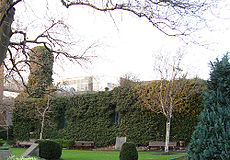St. Kevin's Church, Camden Row, Dublin
| St. Kevin's Church | |
|---|---|

St. Kevin's Church and Churchyard
|
|
| Coordinates: 53°20′11″N 6°16′1″W / 53.33639°N 6.26694°W | |
| Location | Camden Row, Dublin |
| Country | Ireland |
| Denomination | Church of Ireland |
| Previous denomination | Roman Catholic |
| Membership | 73,000 (civil parish in 1901, United Parish of St. Peter and St. Kevin) |
| History | |
| Former name(s) | Eaglais Naomh Caoimhín |
| Founded | Pre-13th century |
| Dedication | Kevin of Glendalough |
| Cult(s) present | Diarmaid Ó hUrthuile |
| Associated people | The 1st Duke of Wellington was baptized in this church, 1769 |
| Architecture | |
| Status | Parish church, since 1680 chapel-of-ease to St. Peter's |
| Functional status | Closed, part of public park |
| Heritage designation | Preservation order |
| Closed | 1912 |
| Administration | |
| Parish | United Parish of St. Peter and St. Kevin |
St. Kevin's Church (Irish: Eaglais Naomh Caoimhín), in St. Kevin's Park, Camden Row, Dublin, Ireland, is a church dating back at least as far as the 13th century, and was dedicated to Kevin of Glendalough.
The church was first mentioned in historical annals in 1226. It was situated some distance from the walls of Dublin, in the Irish part of the city, but close to a monastic settlement in the region of present-day Aungier Street. From the 13th century it formed part of the Manor of St. Sepulchre, which was directly under the jurisdiction of the Archbishop of Dublin. An archaeological excavation carried out in 1967 uncovered some medieval graves and coins. The present ruined church, built on the foundation of the medieval one, dates to around 1750.
The church is the burial place of Archbishop Dermot O'Hurley (Irish: Diarmaid Ó hUrthuile), who was interred here after his execution on 20 June 1584 at Hoggen Green. O'Hurley, ordained Archbishop of Cashel in 1581, was imprisoned and tortured by government authorities upon his return from Rome in 1583. His grave became a place of veneration for Roman Catholics for several hundred years. In 1609, in view of the throngs of pilgrims coming to his grave, the church was rebuilt and a new entrance was made.
In the early years of the Irish Confederate Wars (1641–1649) incursions were made into the church lands surrounding St. Kevin's by bands of Confederate soldiers stationed in Wicklow. Trenches were dug near the church to help protect the city, but the marauders were able to make off with cattle, horses and the occasional merchant who was unlucky enough to find himself in the wrong place at the wrong time, all of which they transported into the "wilds of Wicklow". Despite cease-fires being arranged, this situation continued until the Battle of Rathmines sealed the fate of the Irish and Royalist forces.
In 1698, the time of the Penal Laws, the church was offered to the Huguenot community as a place of worship and cemetery. The graveyard continued to be used by Catholics until the end of the 19th century.
...
Wikipedia
